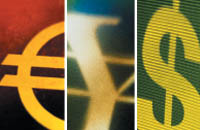The Stock Market Reads Through Strong-Yen Worries
Back to Contents of Issue: March 2004
|
|
|
|
by Darrel Whitten |
|
|
Corporate pension funds, after having returned public-pension money that they used to manage on the behalf of the government, now have smaller numbers of stocks in their portfolios and are becoming more passive in managing these assets.
Many of the major banks have already reduced their stock holdings to below their core equity capital, but they are taking it one step further to reduce the risk to their balance sheet of stock-price fluctuations. Thus the strong rally last year and the sustained high level of trading volume has been a welcome development for the banks, which plan to accelerate their stock sales in fiscal 2004.
With stock holdings of all banks down to JPY26.88 trillion as of the third quarter of 2003 (versus stated equity for all 134 banks of JPY24.84 trillion at the end of March 2003), the banks are now expected to become more selective in unwinding their cross-held and strategic shares: Before unloading these holdings, they're planning to carefully review business relationships and profitability. They also intend to sell holdings to the Bank Stockholding Purchasing Corp., while the Bank of Japan (BOJ) has extended its program of purchasing bank stocks to September 2004.
In the insurance sector, there are hints of a change regarding equities and more selective pruning. Sompo Japan Insurance (8755) is adopting quality benchmarks for a more systematic weeding of its stock portfolios. Sompo has adopted the International Quality Ranking (IQR) model developed by Standard & Poor's to select stocks. The IQR grades stocks on an eight-point scale -- from A-plus to D -- according to how appropriate they are as medium- to long-term investments. The evaluations are based on factors such as sales, profits and dividends per share over the past seven years, adjusting for changes in accounting methods and merger-and-acquisition activity. Sompo is using this methodology to selectively weed our poorly rated stocks (ranked as C in its methodology) and to hold onto or increase its positions in A-rank stocks.
The yen trudges higher
Over JPY20 trillion was spent last year, and over JPY6 trillion, or nearly as much as the prior annual record for intervention, was apparently used by the end of January. Japan's intervention to support the dollar has been increasingly ineffective since the dollar tumbled below JPY115 last September -- the result of implications that the yen might ease after a Group of Seven meeting that called for flexible exchange rates.
Shoichi Nakagawa, Japan's trade minister, states the obvious: "I don't think the US necessarily wants the dollar to strengthen." Japan is becoming increasingly restive. Finance minister Sadakazu Tanigaki notes: "In order to get currencies to reflect economic fundamentals, US deficits need fixing." Despite the diminishing impact of increasingly large interventions and signals to the market that the government fully intends to intervene as much as necessary, Japanese exporters are moving to hedge the risk that the yen will move through the JPY100 milestone this year.
Toyota's move to purchase an option to sell yen at JPY101 to the dollar by August 2004 is evidence that Japan's exporters are moving to hedge their dollar exposure. Compared to when the yen last surged to a historical high of JPY79 to the dollar, Japanese companies are now better prepared. Companies like Pioneer (6773) have shifted the bulk of their production (around 70 percent) overseas in the past 10 years. The overseas production ratio for the manufacturing sector as a whole has risen to just under 40 percent.
Moreover, the yen has been depreciating against the euro, which has gone a long way in offsetting the profit squeeze from its strength against the dollar. For companies like Mazda (7261), Sony (6758) and Japan Victor (6792), the benefits from the depreciation against the euro have outweighed the damage from the strong dollar. Mitsubishi Research Institute estimates that a 1 percent rise in the euro against the yen boosts Japanese corporate profits by JPY32 billion.
The yen's strength against the dollar will hurt manufacturing-sector profits, especially if the yen stays above JPY100 to the dollar for an extended period, as roughly half of Japan's exports are denominated in dollars. Indeed, if the yen moves to around JPY90 to the dollar and stays there indefinitely, it will shave 8 percent off aggregate operating profits in fiscal 2004. Con-versely, it would boost non-manufacturing corporate profits by 6.6 percent. Thus, the total impact on corporate profits would be a minimal minus 0.3 percent, according to some estimates.
Market consensus on strong euro too tight?
Verbal intervention appears to have already begun. Early this year, European Central Bank (ECB) president Jean-Claude Trichet said that a dollar that is too weak is not desirable; France's Jacques Chirac said that unstable exchange rates are detrimental to France's exports -- which are considered a growth engine of their economy; Belgium finance minister Didier Reynders said that ECB monetary policy action would be needed as the euro threatens to break through $1.30. Thus there is likely to be further verbal intervention by European officials and an increasing chance of an ECB interest-rate cut if the euro continues its upward climb.
European efforts to restrain the euro will prompt caution toward dollar-selling, but unless the US is willing to add teeth to the ECB efforts with coordinated intervention, the market impact will be lessened. At the very least, the dollar is due for a short-term rally in a secular bear market. If the pressure on the euro-dollar rate is eased, the focus of the currency markets could turn to the yen-dollar rate and at least temporarily push the yen through the JPY100 level. If, however, the US is willing to cooperate with the ECB, it will be a very strong signal that the US believes the dollar's depreciation has gone far enough.
We must admit that when we first called for an appreciation in the yen to previous highs, we believed that the dollar-sensitive sectors and stocks would under-perform by a wider margin. This has not yet happened. Partially because of the reduced exposure to the dollar, the offsetting favorable effect from a strong euro and heavy intervention by the BOJ to slow the pace of yen-dollar appreciation (as well as expectations for a strong recovery in world trade), the yen's rise so far has not substantially impeded the performance of major blue-chip exporter stock prices.
In that regard, worries about the strong yen, while much fretted about by policy makers and institutional investors, do not appear to be reflected in the stock market's actions. We still believe, however, that breaching JPY100 to the dollar will have a much stronger effect on investors, causing them to take at least short-term profits in the export majors.
On a comparable sector basis (i.e., comparing the Japan S&P 500 to the US S&P 500), the Japan market is overweight in consumer discretionary, industrials, materials, telecom services and utilities, but underweight in IT, financials, consumer staples, health care and energy. The US S&P 500 has actually outperformed the Japan S&P 500 in local currency terms so far in 2004 because of the performance of the IT sector.
@ |
|
Note: The function "email this page" is currently not supported for this page.


 THE PATTERN OF NET buying and selling during the first few months of this year is essentially the same as that seen for most of last year: Buying among foreign investors has accelerated again, while there has been an equally large amount of net selling by domestic financial institutions, corporations and individuals. Indeed, were it not for the net buying by the brokerage companies on their own accounts, Japan's stock market would have a negative supply-demand bias instead of the positive movement in stock prices we have actually seen.
THE PATTERN OF NET buying and selling during the first few months of this year is essentially the same as that seen for most of last year: Buying among foreign investors has accelerated again, while there has been an equally large amount of net selling by domestic financial institutions, corporations and individuals. Indeed, were it not for the net buying by the brokerage companies on their own accounts, Japan's stock market would have a negative supply-demand bias instead of the positive movement in stock prices we have actually seen.
 Currency traders simply don't believe the US administration's rhetoric about a "strong dollar" policy. The US administration says it "favors" a strong dollar policy, but business associates nevertheless believe they will reap a bonanza from the stimulus that a weak dollar will give US exports.
Currency traders simply don't believe the US administration's rhetoric about a "strong dollar" policy. The US administration says it "favors" a strong dollar policy, but business associates nevertheless believe they will reap a bonanza from the stimulus that a weak dollar will give US exports.



